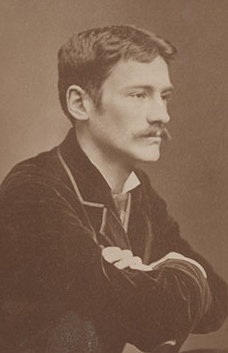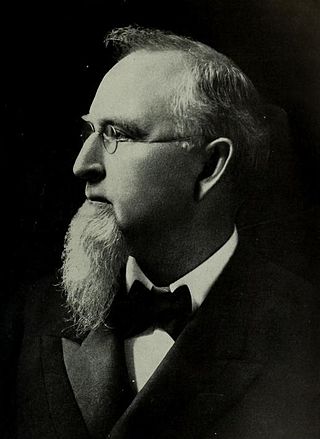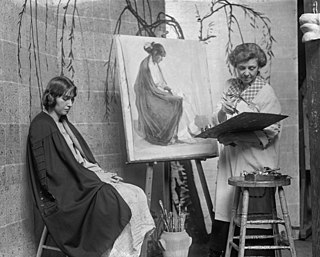
The Smithsonian Institution, or simply the Smithsonian, is a group of museums, education and research centers, the largest such complex in the world, created by the U.S. government "for the increase and diffusion of knowledge". Founded on August 10, 1846, it operates as a trust instrumentality and is not formally a part of any of the three branches of the federal government. The institution is named after its founding donor, British scientist James Smithson. It was originally organized as the United States National Museum, but that name ceased to exist administratively in 1967.

Gilbert Charles Stuart was an American painter from Rhode Island Colony who is widely considered one of America's foremost portraitists. His best-known work is an unfinished portrait of George Washington, begun in 1796, which is sometimes referred to as the Athenaeum Portrait. Stuart retained the portrait and used it to paint scores of copies that were commissioned by patrons in America and abroad. The image of George Washington featured in the painting has appeared on the United States one-dollar bill for more than a century and on various postage stamps of the 19th century and early 20th century.

Julian Alden Weir was an American impressionist painter and member of the Cos Cob Art Colony near Greenwich, Connecticut. Weir was also one of the founding members of "The Ten", a loosely allied group of American artists dissatisfied with professional art organizations, who banded together in 1898 to exhibit their works as a stylistically unified group.

William McGregor Paxton was an American painter and instructor who embraced the Boston School paradigm and was a co-founder of The Guild of Boston Artists. He taught briefly while a student at Cowles Art School, where he met his wife Elizabeth Okie Paxton, and at the Museum of Fine Arts School in Boston. Paxton is known for his portraits, including those of two presidents—Grover Cleveland and Calvin Coolidge—and interior scenes with women, including his wife. His works are in many museums in the United States.

Thomas Wilmer Dewing was an American painter working at the turn of the 20th century. Schooled in Paris, Dewing was noted for his figure paintings of aristocratic women. He was a founding member of the Ten American Painters and taught at the Art Students League of New York. The Freer Gallery of Art at the Smithsonian Institution has a collection of his works. He was the husband of fellow artist Maria Oakey Dewing.

Sanford Robinson Gifford was an American landscape painter and a leading member of the second generation of Hudson River School artists. A highly-regarded practitioner of Luminism, his work was noted for its emphasis on light and soft atmospheric effects.

Thomas Henry Carter was an American politician, who served as territorial delegate, a United States representative, and a U.S. Senator from Montana. Carter was born in Junior Furnace, Ohio, on October 30, 1854. Born to an Irish immigrant family, he spent most of his childhood in on small farms in the Midwest. In 1882, he moved to Helena, Montana to begin his law career there. He entered then politics, and was elected Montana's territorial delegate in 1888. Following Montana's admission into the union as a state, Carter represented the state in U.S. House of Representatives. He ran for re-election in 1890, but was narrowly defeated by Democrat William W. Dixon in the general election.
George Brant Bridgman was a Canadian-American painter, writer, and teacher in the fields of anatomy and figure drawing. Bridgman taught anatomy for artists at the Art Students League of New York for some 45 years.

Moses Soyer was an American social realist painter.

Jennie Augusta Brownscombe was an American painter, designer, etcher, commercial artist, and illustrator. Brownscombe studied art for years in the United States and in Paris. She was a founding member, student and teacher at the Art Students League of New York. She made genre paintings, including revolutionary and colonial American history, most notably The First Thanksgiving held at Pilgrim Hall in Plymouth, Massachusetts. She sold the reproduction rights to more than 100 paintings, and images of her work have appeared on prints, calendars and greeting cards. Her works are in many public collections and museums. In 1899 she was described by New York World as "one of America's best artists."

Louise Howland King Cox was an American painter known for her portraits of children. She won a number of prizes throughout her career, notably a bronze medal at the 1900 Paris Exposition and a silver medal at the 1901 Pan-American Exposition in Buffalo.
Sidney Harry Riesenberg was an illustrator and artist who lived in Yonkers, New York, and commuted to his studio in New York City by train. He was known as a professional illustrator for his posters for the United States Marine Corps and the Liberty bond programs, for his illustrations for book covers, magazines, and for oil paintings of diverse subjects. He retired from his professional work and dedicated his full-time energy to painting fine arts and teaching. In 1937 he began spending summers in Rockport, Massachusetts, where he painted scenes of the small fishing town. He was active in the Rockport Art Association, teaching oil painting and participating in water color figure painting classes.
Jane Stuart was an American painter, best known for her miniature paintings and portraits, particularly those made of George Washington. She worked on and later copied portraits made by her father, Gilbert Stuart, and created her own portraits. In the early 19th century, she assumed the responsibility of supporting her family after her father's death. She first worked in Boston, but later moved to Newport, Rhode Island, where she was the first woman who painted portraits. In 2011, she was inducted into the Rhode Island Heritage Hall of Fame.

CatharineCarter Critcher was an American painter. A native of Westmoreland County, Virginia, she worked in Paris and Washington, D.C. before becoming, in 1924, a member of the Taos Society of Artists, the only woman ever elected to that body. She was a long time member of the Arts Club of Washington.

Harriet Christina Cany Peale (1799–1869) was an American landscape, portrait, and genre painter of the mid-nineteenth century. Although sometimes described as a copyist, a greater share of her oeuvre has been made public in recent years, allowing Cany Peale to earn recognition for her genre and landscape paintings. She has been located in contemporary scholarship as an artist of the Hudson River School.
Ada Gilmore was an American watercolorist and printmaker, one of the Provincetown Printers.

Pietro Bonanni was an Italian-born painter active in the United States.
Dennis Carter may refer to:

Dennis W. Belindo, also called Aun So Te ("Foot") was a Kiowa-Diné painter, educator, analyst and activist. He utilized acrylic, watercolor, and casein for his paintings, which combined the flat style with modernism and cubism to highlight aspects of Kiowa life. Belindo exhibited his artwork across the country and has works in the public collections of several institutions including the Oklahoma Historical Society Museum. Some of his papers are held in the collection of the Smithsonian Institution.













